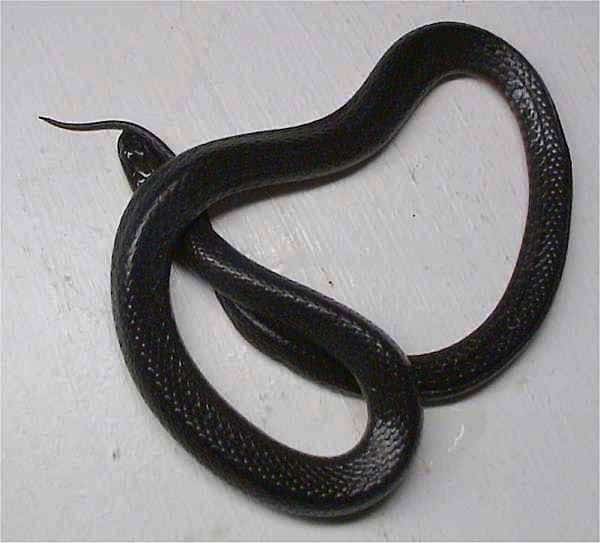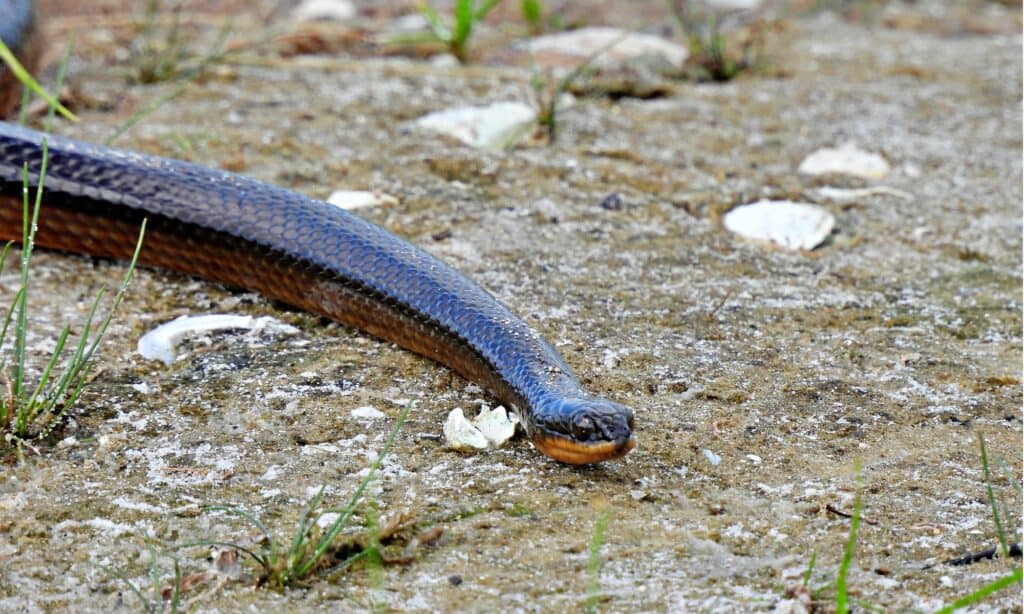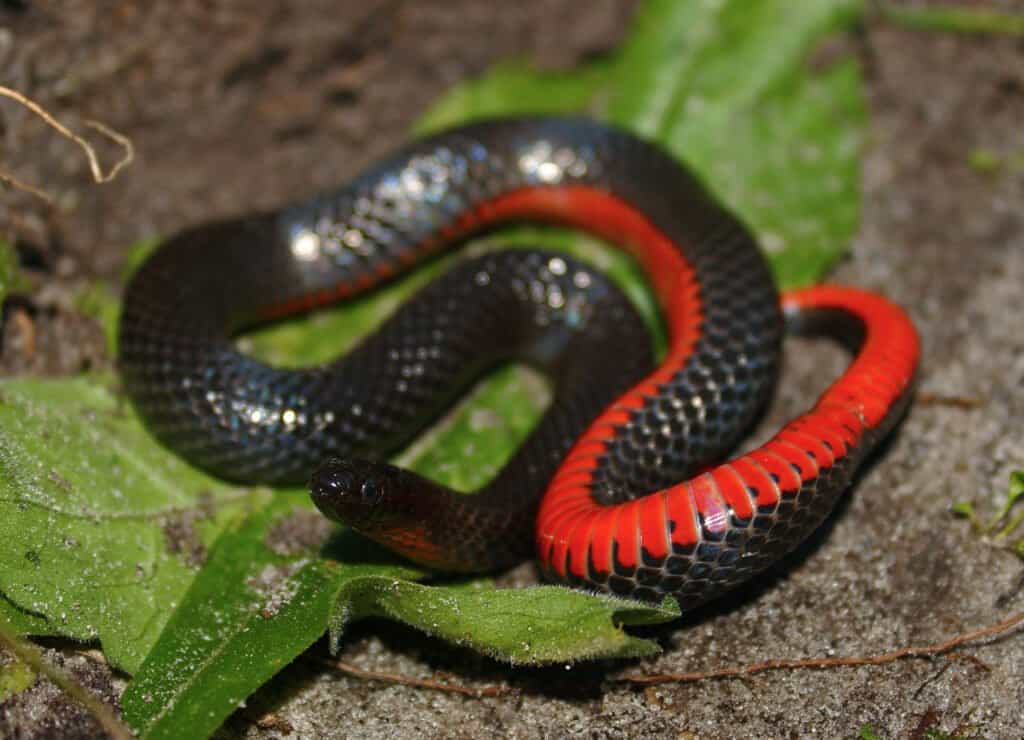Discover the Largest Black Swamp Snake Ever Recorded
The black swamp snake is a small, aquatic, non-venomous snake native to the Eastern United States and the coastal areas of Southeastern Canada. The word pygaea in its scientific name “Liodytes pygaea” is derived from the Greek meaning “fire-like,” possibly referring to their unique color. At 10 to 15 inches, this black snake is tiny in size, and its color allows it to blend easily with its surroundings. But how big do these little slithering creatures get? What is the largest black swamp snake ever found?
Background on the Black Swamp Snake
The black swamp snake is a species of snake in the subfamily Natricinae of the family Colubridae. This species is endemic to the Southeastern United States. Three subspecies are recognized as valid; South Florida swamp snake (Liodytes pygaea cycles), North Florida swamp snake (Liodytes pygaea pygaea), and Carolina swamp snake (Liodytes pygaea paludis),
What Does the Black Swamp Snake Look like?

Dawson / Creative Commons – License
The black swamp snake is a small snake that is grossly shiny black on the dorsum and has a bright red or orange belly with black markings on the edges. The scales on the body are smooth. The head is about the same size as the neck. The black swamp snake is a fairly small, thin, and adult species that measures approximately 10 to 15 inches. Newborns have a total length of roughly 11–14 cm (4¼-5⅜ in), and their coloration is similar to miniature adults. Females are much longer and heavier-bodied, but males have longer and thicker tails.
Because swamp snakes are aquatic snakes, they may be confused with the similar small mud snakes. But to differentiate them, note that mud snakes have red coloration that extends to their sides and a black checkerboard pattern on their belly. Black swamp snakes can also be confused with terrestrial red-bellied black snakes because they have similar red/orange belly patterns. However, the solid black dorsal coloration and aquatic habits of swamp snakes distinguish them from terrestrial red-bellied snakes.
Largest Black Swamp Snake Ever Found

iStock.com/passion4nature
Black swamp snakes are fairly small-sized. They are usually 25–38 cm (10–15 in) long (including the tail). Large swamp snakes measuring about 55 cm (22 in) have been reported. The largest black swamp snake ever found measured 24.5 inches (62.2cm) long.
The Behavior of the Black Swamp Snake
As its name suggests, the black swamp snake is almost entirely an aquatic species. Within the water, it is active both during the day and at night. It spends most of its life hiding among dense aquatic vegetation, especially in swamps, where it actively forages amidst submerged vegetation. Though their black appearance suggests otherwise, they are generally harmless, even when restrained. However, they may release musk from glands at the base of their tail when captured; they rarely bite in defense.
How Do Black Swamp Snakes Reproduce?
Breeding season for this species starts from August through October. The black swamp snake is ovoviviparous, meaning the females give birth to live young ones (about 11 to 13) directly in shallow water. Unlike many other snake species, females feed actively while gravid, suggesting they may pass nutrients to the young.
Black Swamp Snakes: Range
The black swamp snake is widely distributed across South Carolina, North Carolina, Georgia, Florida, and Alabama. Its range extends from the Coastal Plain of the southeastern United States from eastern North Carolina west to southern Alabama and Florida, extending up to 150 to 180 km (93 to 112 miles) inland from Georgia and South Carolina coasts.
Where Do Swamp Snakes Live?
Black swamp snakes occupy various open aquatic habitats, including swampy areas, marshes, sphagnum bogs, bay heads, Carolina bays, wet grassy prairies, and roadside ditches. They’ve also been found to inhabit the borders of heavily-vegetated wetlands, ponds, and lakes.
Black swamp snakes are docile and extremely secretive. Even though they are abundant in some habitats, they are rarely seen, even by experienced herpetologists. These shy little snakes prefer to hide among vegetation in water or under debris at the water’s edge, particularly on sunny spring days. But occasionally, this species has been found crossing roads during summer after heavy rainy nights. They may also travel on land when pond basins dry up.
What Do Black Swamp Snakes Eat?

Peter Paplanus / flickr – License
Black swamp snakes feed on aquatic prey, including tadpoles, small fish, frogs, sirens, salamanders, and invertebrates, such as earthworms and leeches. They are sit-and-wait ambush predators known to swallow their prey alive without first constricting them.
How Dangerous Are Black Swamp Snakes?
The black swamp snake is a non-venomous species and is not dangerous to people or pets. When threatened, these docile snakes typically do not bite in defense; instead, they attempt to escape quickly. Because they live under submerged vegetation, people sometimes step on this snake which could cause it to be forced to bite in self-defense. Though they do not have venom glands in their mouth, direct handling should also be avoided as a bite may cause mild reactions ranging from itching and swelling to nausea and dizziness.
How Long Do Black Swamp Snakes Live?
Black swamp snakes have an average lifespan of about seven years when left in the wild. However, they can live up to about 20 years when in captivity.
Conservation Status of the Black Swamp Snake
Black swamp snakes are listed as “Least Concern” on the IUCN Red List of Threatened Species. Their population is relatively stable. However, little is known about this species’s status in most areas because of its secretive and highly-aquatic habits. They also rely heavily on fishless wetlands, making them vulnerable to habitat destruction. For this reason, this species is of conservation concern throughout its range. They are protected throughout states such as Georgia.
Discover the “Monster” Snake 5X Bigger than an Anaconda
Every day A-Z Animals sends out some of the most incredible facts in the world from our free newsletter. Want to discover the 10 most beautiful snakes in the world, a “snake island” where you’re never more than 3 feet from danger, or a “monster” snake 5X larger than an anaconda? Then sign up right now and you’ll start receiving our daily newsletter absolutely free.
More from A-Z Animals
The black swamp snake is a small, aquatic, non-venomous snake native to the Eastern United States and the coastal areas of Southeastern Canada. The word pygaea in its scientific name “Liodytes pygaea” is derived from the Greek meaning “fire-like,” possibly referring to their unique color. At 10 to 15 inches, this black snake is tiny in size, and its color allows it to blend easily with its surroundings. But how big do these little slithering creatures get? What is the largest black swamp snake ever found?
Background on the Black Swamp Snake
The black swamp snake is a species of snake in the subfamily Natricinae of the family Colubridae. This species is endemic to the Southeastern United States. Three subspecies are recognized as valid; South Florida swamp snake (Liodytes pygaea cycles), North Florida swamp snake (Liodytes pygaea pygaea), and Carolina swamp snake (Liodytes pygaea paludis),
What Does the Black Swamp Snake Look like?

Dawson / Creative Commons – License
The black swamp snake is a small snake that is grossly shiny black on the dorsum and has a bright red or orange belly with black markings on the edges. The scales on the body are smooth. The head is about the same size as the neck. The black swamp snake is a fairly small, thin, and adult species that measures approximately 10 to 15 inches. Newborns have a total length of roughly 11–14 cm (4¼-5⅜ in), and their coloration is similar to miniature adults. Females are much longer and heavier-bodied, but males have longer and thicker tails.
Because swamp snakes are aquatic snakes, they may be confused with the similar small mud snakes. But to differentiate them, note that mud snakes have red coloration that extends to their sides and a black checkerboard pattern on their belly. Black swamp snakes can also be confused with terrestrial red-bellied black snakes because they have similar red/orange belly patterns. However, the solid black dorsal coloration and aquatic habits of swamp snakes distinguish them from terrestrial red-bellied snakes.
Largest Black Swamp Snake Ever Found

iStock.com/passion4nature
Black swamp snakes are fairly small-sized. They are usually 25–38 cm (10–15 in) long (including the tail). Large swamp snakes measuring about 55 cm (22 in) have been reported. The largest black swamp snake ever found measured 24.5 inches (62.2cm) long.
The Behavior of the Black Swamp Snake
As its name suggests, the black swamp snake is almost entirely an aquatic species. Within the water, it is active both during the day and at night. It spends most of its life hiding among dense aquatic vegetation, especially in swamps, where it actively forages amidst submerged vegetation. Though their black appearance suggests otherwise, they are generally harmless, even when restrained. However, they may release musk from glands at the base of their tail when captured; they rarely bite in defense.
How Do Black Swamp Snakes Reproduce?
Breeding season for this species starts from August through October. The black swamp snake is ovoviviparous, meaning the females give birth to live young ones (about 11 to 13) directly in shallow water. Unlike many other snake species, females feed actively while gravid, suggesting they may pass nutrients to the young.
Black Swamp Snakes: Range
The black swamp snake is widely distributed across South Carolina, North Carolina, Georgia, Florida, and Alabama. Its range extends from the Coastal Plain of the southeastern United States from eastern North Carolina west to southern Alabama and Florida, extending up to 150 to 180 km (93 to 112 miles) inland from Georgia and South Carolina coasts.
Where Do Swamp Snakes Live?
Black swamp snakes occupy various open aquatic habitats, including swampy areas, marshes, sphagnum bogs, bay heads, Carolina bays, wet grassy prairies, and roadside ditches. They’ve also been found to inhabit the borders of heavily-vegetated wetlands, ponds, and lakes.
Black swamp snakes are docile and extremely secretive. Even though they are abundant in some habitats, they are rarely seen, even by experienced herpetologists. These shy little snakes prefer to hide among vegetation in water or under debris at the water’s edge, particularly on sunny spring days. But occasionally, this species has been found crossing roads during summer after heavy rainy nights. They may also travel on land when pond basins dry up.
What Do Black Swamp Snakes Eat?

Peter Paplanus / flickr – License
Black swamp snakes feed on aquatic prey, including tadpoles, small fish, frogs, sirens, salamanders, and invertebrates, such as earthworms and leeches. They are sit-and-wait ambush predators known to swallow their prey alive without first constricting them.
How Dangerous Are Black Swamp Snakes?
The black swamp snake is a non-venomous species and is not dangerous to people or pets. When threatened, these docile snakes typically do not bite in defense; instead, they attempt to escape quickly. Because they live under submerged vegetation, people sometimes step on this snake which could cause it to be forced to bite in self-defense. Though they do not have venom glands in their mouth, direct handling should also be avoided as a bite may cause mild reactions ranging from itching and swelling to nausea and dizziness.
How Long Do Black Swamp Snakes Live?
Black swamp snakes have an average lifespan of about seven years when left in the wild. However, they can live up to about 20 years when in captivity.
Conservation Status of the Black Swamp Snake
Black swamp snakes are listed as “Least Concern” on the IUCN Red List of Threatened Species. Their population is relatively stable. However, little is known about this species’s status in most areas because of its secretive and highly-aquatic habits. They also rely heavily on fishless wetlands, making them vulnerable to habitat destruction. For this reason, this species is of conservation concern throughout its range. They are protected throughout states such as Georgia.
Discover the “Monster” Snake 5X Bigger than an Anaconda
Every day A-Z Animals sends out some of the most incredible facts in the world from our free newsletter. Want to discover the 10 most beautiful snakes in the world, a “snake island” where you’re never more than 3 feet from danger, or a “monster” snake 5X larger than an anaconda? Then sign up right now and you’ll start receiving our daily newsletter absolutely free.







